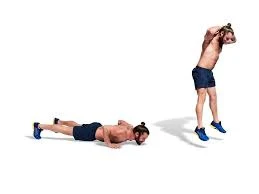Bodyweight exercises are becoming the go-to choice for many fitness enthusiasts. As we head into 2025, there’s no better time to explore why this training method is capturing attention and how you can make it work for you.
The Fitness Revolution: Why Bodyweight Training is Trending
Bodyweight exercises are popular for various reasons. They require no fancy equipment, making it easy to workout anywhere—home, park, or gym. The growing awareness of health benefits is driving people to adopt this versatile approach.
The Benefits of Bodyweight Exercises: Strength, Flexibility, and More
- Strength Building: You can develop muscle using just your body weight.
- Flexibility: Many bodyweight moves promote flexibility and mobility.
- Endurance: These workouts can increase stamina over time.
- Convenience: No gym membership? No problem. You can train anytime, anywhere.
- Affordability: No need for expensive gear; your body is your tool.
Setting Realistic Goals and Expectations for 2025
Setting achievable fitness goals is crucial. Here are some tips:
- Start small: Aim to work out a few times a week.
- Track your progress: Keep a journal or use an app to note your improvements.
- Be patient: Real change takes time, so celebrate small victories along the way.
Fundamental Bodyweight Exercises
Mastering the Basics: Squats, Push-ups, and Lunges
Start with a few key movements:
- Squats: Great for legs and glutes. Stand with feet shoulder-width apart, lower your hips as if you're sitting, then stand back up.
- Push-ups: Perfect for upper body strength. Begin in a plank position, lower your body until your chest is near the ground, then push back up.
- Lunges: Boost leg strength. Step forward with one leg, lower your hips, and ensure your front knee is over your ankle.
Building Strength: Variations and Progressions for Intermediate Levels
Once you're comfortable with the basics, try these:
- Pistol Squats: A single-leg squat that challenges balance and strength.
- Decline Push-ups: Place your feet on an elevated surface.
- Walking Lunges: Step forward, alternating legs for added endurance.
Essential Tips for Proper Form and Injury Prevention
- Warm-up: Always stretch before exercises.
- Alignment: Keep your body straight to avoid strain.
- Listen to your body: Never push through pain.
Full-Body Bodyweight Workouts
Sample Workout Routine for Beginners: 3 Days a Week
Day 1:
- Squats: 3 sets of 10
- Push-ups: 3 sets of 8
- Lunges: 3 sets of 10 per leg
Day 2:
- Planks: 3 sets of 30 seconds
- Glute Bridges: 3 sets of 12
- Side Lunges: 3 sets of 10 per side
Day 3:
- Jumping Jacks: 3 sets of 15
- Wall Sits: 3 sets of 20 seconds
- Bear Crawls: 3 sets for 30 seconds
Intermediate Routine: Incorporating Advanced Exercises and Increased Intensity
For those ready for a challenge, add these:
- Burpees: Full-body strength with cardio.
- Handstand Push-ups: Advanced shoulder strength.
- Tuck Jumps: Boost power and explosiveness.
Tracking Progress and Adjusting Workouts Based on Results
Use apps to note improvements. If a routine feels easy, increase reps or try harder variations to continue building strength.
Targeted Bodyweight Training
Upper Body Strength: Chest, Back, Shoulders, and Arms
- Dips: Use a chair or bench to dip your body.
- Dive Bomber Push-ups: Combine yoga and strength for incredible results.
Lower Body Strength: Legs and Glutes
- Single-Leg Deadlifts: Great for hamstrings and glutes.
- Calf Raises: Stand on a step and lift your heels.
Core Strength: Planks, Crunches, and Russian Twists
Core strength is vital. Incorporate:
- Planks: Regular and side planks for core stability.
- Russian Twists: Sit on the ground and rotate your torso side to side.
Nutrition and Recovery for Optimal Results
The Importance of Fueling Your Body: Balanced Diet for Fitness
Eating a balanced diet is key. Focus on:
- Lean proteins: Chicken, fish, and legumes.
- Whole grains: Brown rice or oats for energy.
- Fruits and vegetables: Provide essential vitamins and minerals.
Hydration and Sleep: Critical Components of Recovery
- Stay Hydrated: Aim for 8-10 glasses of water daily.
- Rest Well: Aim for 7-9 hours of sleep to help your muscles recover.
Incorporating Rest Days into Your Fitness Plan
Rest days are just as important as workout days. Aim for at least one full rest day each week to prevent burnout.
Staying Motivated and Consistent
Finding a Workout Buddy or Fitness Community
Working out with a friend can boost motivation. Join local fitness groups or online communities for support.
Setting Small, Achievable Goals and Celebrating Successes
Break larger goals into smaller, achievable steps. Celebrate these victories to keep your momentum.
Using Technology and Fitness Apps to Stay on Track
Fitness apps can help monitor progress and provide workout ideas. Consider apps like MyFitnessPal or Strava.
Conclusion: Achieving Your Fitness Goals in 2025
Getting fit in 2025 is about consistency and commitment. Focus on proper form, maintain a balanced approach to training, and don’t ignore nutrition.
Key Takeaways: Consistency, Proper Form, and Balanced Approach
Remember, progress is more important than perfection. Stay committed and keep adjusting your goals.
Looking Ahead: Continued Learning and Progression in Bodyweight Training
Keep seeking new exercises and methods to challenge your body. Fitness is an ongoing journey.
Resources: Recommended Apps, Websites, and Fitness Professionals
Explore platforms like YouTube for workout videos or follow fitness professionals on social media for tips and motivation. Stay connected to the fitness community as you embark on your journey to a fitter 2025.
